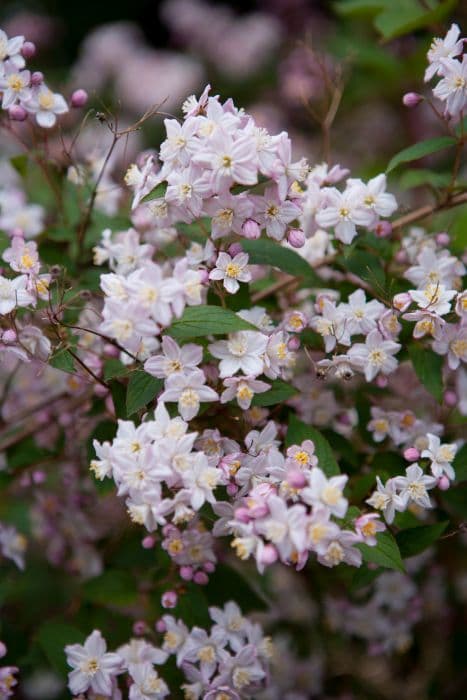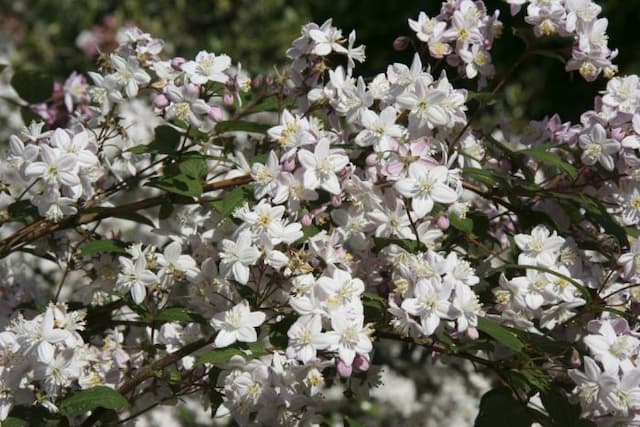Japanese hydrangea vine Schizophragma hydrangeoides

ABOUT
The plant commonly known as Japanese hydrangea vine is a perennial climbing plant known for its ability to latch onto surfaces with aerial rootlets. This vine is adorned with broad, heart-shaped leaves that have a serrated edge, creating a lush, full green coverage wherever it climbs. The foliage changes color throughout the seasons, emerging with a bronze tint in spring, maturing to a rich green in summer, and then transforming to a yellow hue in autumn. One of the most striking features of the Japanese hydrangea vine is its flower display. It blooms in the summer, producing clusters of small, creamy white, and inconspicuous flowers that are surrounded by larger, showy white bracts. These bracts are often mistaken for the true flowers due to their size and prominence. The floral display resembles that of its namesake, the hydrangea, and it adds an ornate and attractive quality to the plant. The bark of the Japanese hydrangea vine is brown and has a peeling quality that adds textural interest, particularly during the winter months when the plant is leafless. This combination of attractive foliage, striking floral bracts, and interesting bark make the Japanese hydrangea vine a plant of choice for gardeners looking to cover walls, fences, or trellises with an impressive ornamental plant.
About this plant
 Names
NamesFamily
Hydrangeaceae.
Synonyms
Japanese Hydrangea Vine, False Hydrangea Vine, Climbing Hydrangea.
Common names
Schizophragma hydrangeoides Sieb. & Zucc., Schizophragma hydrangeoides f. hydrangeoides.
 Toxicity
ToxicityTo humans
Japanese hydrangea vine (Schizophragma hydrangeoides) is not commonly known to be toxic to humans. However, even in the absence of well-known toxicity, it is generally advisable to avoid ingesting plants that are not specifically intended for human consumption, as they can sometimes cause adverse reactions such as gastrointestinal upset or allergic reactions.
To pets
Japanese hydrangea vine is not widely recognized as a toxic plant to pets. However, caution is always recommended since the ingestion of any plant material can potentially cause mild stomach upset in some animals. If a pet ingests a significant quantity of the plant and exhibits symptoms such as vomiting, diarrhea, or unusual behavior, it is wise to consult a veterinarian.
 Characteristics
CharacteristicsLife cycle
Perennials
Foliage type
Deciduous
Color of leaves
Green
Flower color
White
Height
30 feet (9 meters)
Spread
20 feet (6 meters)
Plant type
Climber
Hardiness zones
5
Native area
Japan
Benefits
 General Benefits
General Benefits- Aesthetic Appeal: The Japanese hydrangea vine adds visual interest to gardens with its heart-shaped foliage and lacecap hydrangea-like flowers in summer.
- Versatility: It can be used as a climbing plant on walls, trellises, and arbors or as a ground cover if there's no vertical space available.
- Shade Tolerance: It thrives in partial to full shade, making it suitable for understory planting in woodland gardens or north-facing aspects.
- Seasonal Interest: The plant offers seasonal changes, with attractive foliage and blooms in summer followed by interesting seed pods in fall.
- Low Maintenance: Once established, it requires minimal care beyond occasional pruning to control its size and shape.
- Attracts Pollinators: The flowers are attractive to bees and butterflies, promoting biodiversity in the garden.
- Architectural Structure: It can provide structural support for other climbing plants when used in combination, creating layers in garden design.
- Decorative Bark: The peeling, cinnamon-colored bark offers winter interest and textural contrast in the garden.
- Wildlife Shelter: The dense foliage can provide shelter for birds and small mammals.
- Rapid Growth: It has a fast growth rate which allows for quick coverage of unsightly areas or creation of green spaces.
- Drought Tolerance: Once established, it exhibits some drought tolerance, reducing the need for frequent watering in temperate climates.
 Medical Properties
Medical PropertiesThis plant is not used for medical purposes.
 Air-purifying Qualities
Air-purifying QualitiesThis plant is not specifically known for air purifying qualities.
 Other Uses
Other Uses- Japanese hydrangea vine can be used as a natural dye; its leaves may produce various shades of green or yellow when processed correctly.
- The plant's fibrous stems can be used for making small craft items such as woven baskets or decorations.
- Its large, attractive leaves can be included in floral arrangements as a filler to add texture and a lush green backdrop.
- Japanese hydrangea vine can be grown as a ground cover in shaded areas where other plants might struggle to thrive.
- The rough texture of the vine's bark has been used in small-scale rustic crafts, such as making natural tags or labels for gardens or gifts.
- When pruned, the wood of the Japanese hydrangea vine can be used for smoking meats to impart a unique flavor.
- Thick growths of the vine can provide small wildlife, such as birds or insects, with shelter and a habitat within gardens.
- Dried sections of the vine can be used to create unique, rustic-looking trellises or supports for other climbing plants.
- During autumn, the plant's changing leaf colors can be used as seasonal decorations both indoors and outdoors.
- The vine's ability to adhere to surfaces can help control erosion by stabilizing soil on slopes or banks.
Interesting Facts
 Feng Shui
Feng ShuiThe Japanese hydrangea vine is not used in Feng Shui practice.
 Zodiac Sign Compitability
Zodiac Sign CompitabilityThe Japanese hydrangea vine is not used in astrology practice.
 Plant Symbolism
Plant Symbolism- Endurance: Schizophragma hydrangeoides, commonly known as the Japanese hydrangea vine, is known for its ability to cling and grow on various surfaces, symbolizing the ability to endure and persist even in challenging conditions.
- Support: As a climbing plant, it often requires the support of a structure or tree to grow, representing support in relationships and the need for collaboration or partnership.
- Overcoming Obstacles: Its vigorous growth habit and ability to overcome gravity by climbing symbolize the determination to overcome obstacles and rise above difficulties.
- Adaptability: The plant's capacity to adapt to different host trees and environments serves as a symbol for adaptability and flexibility in life.
- Heartfelt Emotions: Since the plant is related to the hydrangea family, which is often associated with heartfelt emotions and gratitude, the Japanese hydrangea vine may also carry these symbolic meanings.
 Water
WaterThe Japanese hydrangea vine should be watered regularly to maintain evenly moist soil, especially during the growing season. This plant generally needs thorough watering once a week, but this may vary depending on climate conditions like heat and humidity. During hot, dry periods, it might require water twice a week. Each watering session should provide enough water to soak the root zone, which could translate to about 1-2 gallons for a mature plant in the ground. Reduce watering in the winter months when the plant is dormant.
 Light
LightThe Japanese hydrangea vine thrives in partial shade but can tolerate full shade. It prefers a location where it is shielded from harsh afternoon sun, which could scorch its leaves. Morning light or dappled sunlight is ideal for this vine, offering the right balance without the intensity of direct midday rays. Avoid placing it in full sun, as it doesn't fare well with excessive light exposure.
 Temperature
TemperatureThe Japanese hydrangea vine grows well in a range of temperatures but prefers a setting between 60°F and 80°F, which provides an ideal climate for healthy growth. It can survive minimum temperatures of around 5°F once established and can tolerate maximum temperatures up to about 95°F. This plant is fairly hardy but should be sheltered from extreme cold or frost.
 Pruning
PruningThe Japanese hydrangea vine benefits from pruning to remove dead or damaged growth and to maintain its shape. It's best to prune in late winter or early spring before new growth begins. This plant doesn't require heavy pruning, so simply trim as needed to manage its size and remove any unwanted stems. Be sure to use clean, sharp pruning tools to make clean cuts and minimize damage to the plant.
 Cleaning
CleaningAs needed
 Soil
SoilJapanese hydrangea vine thrives in well-draining soil rich in organic matter, with an ideal pH range of 5.5 to 7.0. A mix of loamy soil, peat, compost, and a bit of sand for drainage is recommended to foster healthy growth.
 Repotting
RepottingThe Japanese hydrangea vine does not require frequent repotting; it's typically done every 3 to 5 years or when the plant becomes pot-bound. Repotting should be done in the spring to allow for season-long growth.
 Humidity & Misting
Humidity & MistingJapanese hydrangea vine prefers moderate to high humidity levels; aiming for a humidity level around 60% is ideal for this plant. A pebble tray or regular misting can help maintain appropriate moisture in the air.
 Suitable locations
Suitable locationsIndoor
Provide bright, indirect light and keep soil moist.
Outdoor
Plant in partial shade, mulch root zone, keep soil moist.
Hardiness zone
5-9 USDA
 Life cycle
Life cycleThe life of the Japanese hydrangea vine (Schizophragma hydrangeoides) begins with seed germination, which requires a period of cold stratification to break dormancy. Upon germination, the seedling emerges and establishes itself, putting out roots and a shoot. The plant then enters a vegetative growth phase, where it will develop its characteristic heart-shaped leaves and begin to climb, using aerial rootlets to attach to surfaces. As it matures, it will produce clusters of creamy-white, petal-like bracts that surround much smaller flowers, usually in mid to late summer. After pollination, typically by bees, the plant sets seeds that are dispersed by wind. Finally, the Japanese hydrangea vine either enters a period of dormancy in colder climates during winter or continues to grow in milder regions, all the while increasing in size and foliage density over the years.
 Propogation
PropogationPropogation time
Spring-Early Summer
The Japanese hydrangea vine (Schizophragma hydrangeoides) can be propagated through softwood cuttings taken in early summer. To achieve this, select a healthy, non-flowering stem and cut a section about 4 to 6 inches (10 to 15 cm) long, making sure at least two sets of leaves are present. Remove the leaves from the lower half of the cutting and dip the cut end into a rooting hormone powder to increase the chances of successful rooting. Plant the cutting in a well-draining potting mix, ensuring the leaf nodes where you removed the lower leaves are buried. Keep the soil consistently moist and cover the pot with a plastic bag or place it in a propagator to maintain humidity. Roots typically develop within a few weeks, after which the cutting can be transplanted into a larger pot or directly into the garden.








![Hydrangea [Early Sensation]](/_next/image?url=https%3A%2F%2Fplants-admin.emdemapps.com%2Fimages%2Fplants%2F%2Fimages%2F604b6150338db.png&w=640&q=75)
